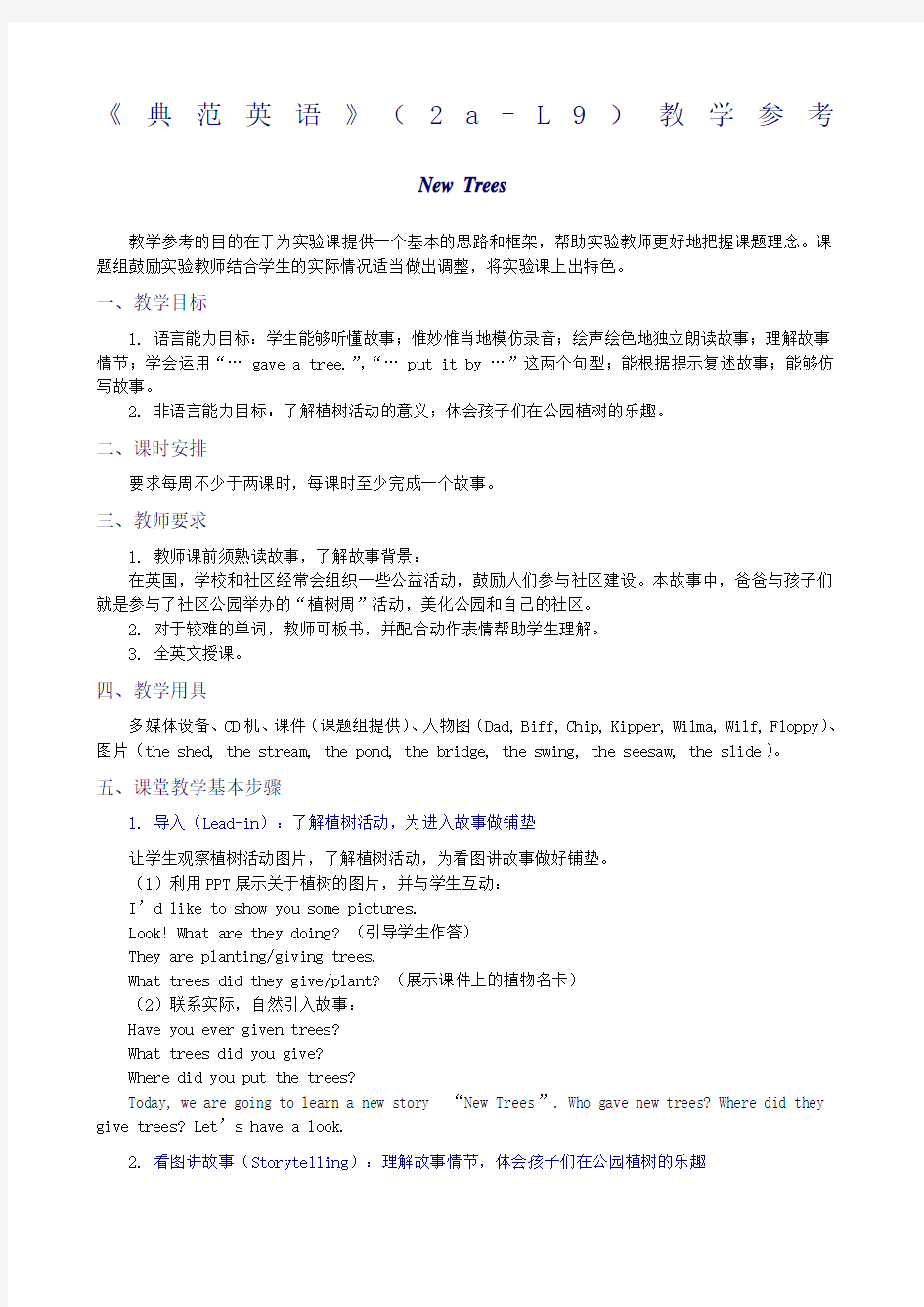典范英语a-L教学参考

- 1、下载文档前请自行甄别文档内容的完整性,平台不提供额外的编辑、内容补充、找答案等附加服务。
- 2、"仅部分预览"的文档,不可在线预览部分如存在完整性等问题,可反馈申请退款(可完整预览的文档不适用该条件!)。
- 3、如文档侵犯您的权益,请联系客服反馈,我们会尽快为您处理(人工客服工作时间:9:00-18:30)。
《典范英语》(2a-L9)教学参考
New Trees
教学参考的目的在于为实验课提供一个基本的思路和框架,帮助实验教师更好地把握课题理念。课题组鼓励实验教师结合学生的实际情况适当做出调整,将实验课上出特色。
一、教学目标
1. 语言能力目标:学生能够听懂故事;惟妙惟肖地模仿录音;绘声绘色地独立朗读故事;理解故事情节;学会运用“… gave a tree.”,“… put it by …”这两个句型;能根据提示复述故事;能够仿写故事。
2. 非语言能力目标:了解植树活动的意义;体会孩子们在公园植树的乐趣。
二、课时安排
要求每周不少于两课时,每课时至少完成一个故事。
三、教师要求
1. 教师课前须熟读故事,了解故事背景:
在英国,学校和社区经常会组织一些公益活动,鼓励人们参与社区建设。本故事中,爸爸与孩子们就是参与了社区公园举办的“植树周”活动,美化公园和自己的社区。
2. 对于较难的单词,教师可板书,并配合动作表情帮助学生理解。
3. 全英文授课。
四、教学用具
多媒体设备、CD机、课件(课题组提供)、人物图(Dad, Biff, Chip, Kipper, Wilma, Wilf, Floppy)、图片(the shed, the stream, the pond, the bridge, the swing, the seesaw, the slide)。
五、课堂教学基本步骤
1. 导入(Lead-in):了解植树活动,为进入故事做铺垫
让学生观察植树活动图片,了解植树活动,为看图讲故事做好铺垫。
(1)利用PPT展示关于植树的图片,并与学生互动:
I’d like to show you some pictures.
Look! What are they doing? (引导学生作答)
They are planting/giving trees.
What trees did they give/plant? (展示课件上的植物名卡)
(2)联系实际,自然引入故事:
Have you ever given trees?
What trees did you give?
Where did you put the trees?
Today, we are going to learn a new story “New Trees”. Who gave new trees? Where did they give trees? Let’s have a look.
2. 看图讲故事(Storytelling):理解故事情节,体会孩子们在公园植树的乐趣
教师利用课件逐幅播放故事图片,并用丰富的表情、生动的英文和适当的肢体语言给学生绘声绘色地讲故事,让学生观察图片,了解孩子们和爸爸种树的过程,体会在公园植树的乐趣。
(Picture 1)Dad and the children went to the park.
Floppy went too.
What did they want to do?
(Picture 2)It was “Give a tree” week.
Everyone wanted to give trees.
Dad went to buy some trees.
Look! What’s this? (引导学生观察袋子上的文字Bone Meal)
It’s Bone Meal. What is it used for? (BQ:Is it for dogs? Is it for trees?)(Picture 3)Dad gave a tree.
He put it by the shed. (教师指向图片中的shed)
Look at the card! What tree did Dad give? (引导学生观察树上的卡片和卡片
上的内容)
Dad gave an oak tree.
Where was Floppy? What was he doing? (引导学生观察Floppy的动作,鼓励学
生大胆推测)
(Picture 4)Chip gave a tree.
He put it by the stream. (教师指向图片中的stream)
What tree did Chip give? (引导学生观察树上的卡片和卡片上的内容)
It was a willow tree.
(Picture 5)Biff gave a tree.
It was a beech tree. (引导学生观察树上的卡片和卡片上的内容)
Where did Biff put the tree? (BQ: Did she put it by the shed?)
She put it by the pond. (教师指向图片中的pond)
(Picture 6)Look! Wilf gave a tree.
He put it by the bridge. (教师指向图片中的bridge)
It was a chestnut tree. (引导学生观察树上的卡片和卡片上的内容)
What did Floppy get?
Floppy got a bone.
(Picture 7)Wilma gave a tree.
The lady helped her.
It was a maple tree. (引导学生观察树上的卡片和卡片上的内容)
She put it by the swing. (教师指向图片中的swing)
What did Floppy do?
(Picture 8)Floppy dug a hole.
Did Floppy give a tree?
No. Floppy gave a bone. He put it in the hole.
(Picture 9)Dad and the children made a card for Floppy’s bone.
“A funny tree,” said Chip.
“A funny bone,” said Dad.
本环节中,教师要把握故事主线,无需过度关注细节,并尽量使用符合学生实际水平的英文。教师要注意启发学生思考,每次提问之后稍作停顿,不要急于说出答案,先观察学生的反应,如学生仍回答困难,再进一步给出提示引导学生作答。
3. 听录音模仿(Listening and Imitating):听懂录音并模仿出标准的语音语调
